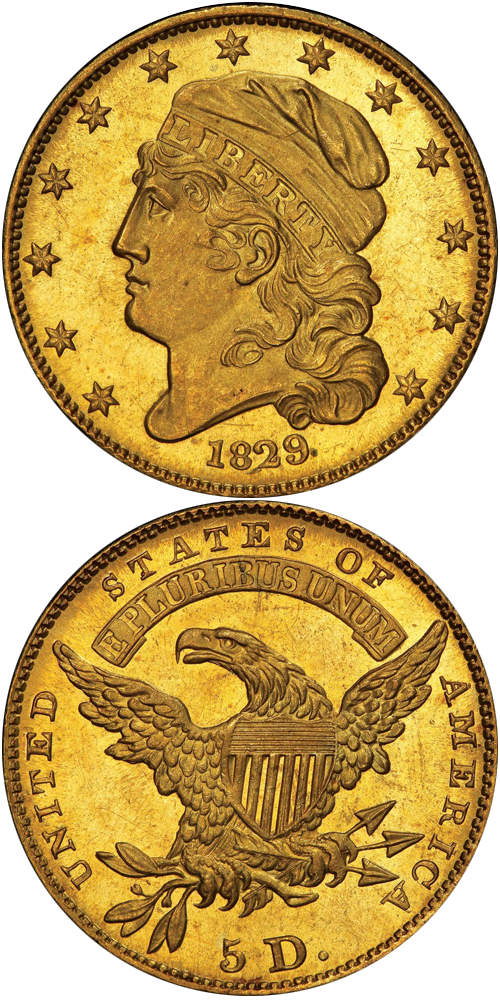1829 Capped Head Left Half Eagle
Reduced Diameter
In autumn 1827, a new screw press arrived at the United States Mint from the Philadelphia machining firm of Rush and Muhlenberg. Weighing nearly three tons, the press was extraordinarily powerful; researcher Craig Sholley has suggested that the new press likely served primarily as a hubbing press. Soon after the new presses' arrival, the Mint began to modify their dies, beginning with dimes in 1828, continuing with half dimes, quarter eagles, and half eagles in 1829, and finally changing over quarters in 1831. The diameters were shrunk and the peripheral rims were raised, allowing for higher relief on the portrait and better striking detail throughout.
When B.L.C. Wailes visited Philadelphia from his home in Natchez, Mississippi at Christmastime 1829, he saw coins just like this one being struck. His journal, published in The Pennsylvania Magazine of History and Biography in July 1954, carefully described the minting apparatus, including the usage of a collar to imbue the reeded edge device. Wailes described the two-piece close collar as "a pair of nippers (which gives the milling or impression on the edges)." His visit to the Mint on December 28, 1829 provides one of the best eyewitness accounts of the Mint's operations during this era.
“I presume 60 pieces may be stamped per minute, the cutting is done equally fast. A great quantity of N. Carolina & Virginia gold is required. But it is said they are immediately shipped to Europe bearing a handsome premium. I must have seen 100 pounds of gold in bars & hoops ready to be manufactured into half eagles. I learn that the precious metals are deposited by individuals. They are then refined & assayed & the true value ascertained & the full weight is given in coins. The number of hands employed is said to be about 20, & the establishment costs the government about 40,000 dollars annually, the expense of the establishment itself not being defrayed out of the coining. Mr. Eckfeldt, one of the superintendents (the second in grade) is an artist & has been in the Mint from its first establishment.”
A group of half eagles was deposited with the Mint treasurer on December 31, from which four coins were reserved for assay, and a further delivery of 1829 half eagles was made on February 6, from which three coins were saved for the assay to take place on February 8, 1830.
Though more than 15,000 coins were delivered on December 31, few of them entered circulation and fewer still survived for any significant length of time. When John W. Haseltine cataloged the William J. Jenks collection in 1883, he remarked on the 1829 Small Planchet half eagle, "I do not know that collectors are generally aware of its existence, as I believe that never but one has made its appearance in a sale."
Unlike the Large Planchet 1829 half eagles, which are all relatively high grade but one, the Small Planchet coins of this year have not all survived so fine. Two Proofs are known, both in institutional collections, the National Numismatic Collection at the Smithsonian Institution and the Harry Bass Foundation. The Smithsonian also holds the lightly circulated Lilly coin. The Bass duplicate, earlier from the H.P. Smith and William F. Dunham collections, has been graded MS-61 (PCGS). While the PCGS Population Report lists one coin graded in MS-61, MS-62, and MS-63, Teichman's census lists the Garrett coin as "Choice AU," the Stickney-Brand coin as "AU," the Fred E. Davies coin as "Choice AU," and the Eliasberg coin as "XF cleaned." Presumably one or both of the Garrett and Davies coins have received the MS-62 and MS-63 grades from PCGS, which has graded but four examples of this issue in all grades.
The example to the left was sold by Stack's Bowers Galleries in the D. Brent Pogue Part IV Auction, where it realized $763,750.






